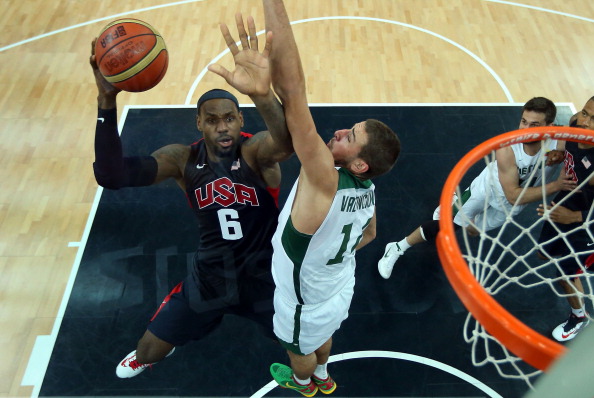The Game:
After two games in which Team USA didn't have to be particularly engaged to coast to easy victories, Lithuania gave the Americans all they could handle Saturday. Paced by Linas Kleiza (25 pts, 10-20 FG), the Lithuanians stood toe to toe with the best team in the world for 40 minutes. A first-quarter onslaught by Team USA saw them jet out an eight-point lead, but thanks to some inspired play by big men Paulius Jankunas and Darius Songaila, the Lithuanians rallied to make it a four-point affair come halftime.

From that point on, it was a real battle in which the scrappy underdog answered every American run with poise and toughness. Thanks to some clever tactics employed by head coach Kestutis Kemzura, Lithuania even managed to hold the lead early in the fourth period.
Then, to stave off an upset, LeBron James (20 pts, 9-14 FG) took over. James tallied 9 points in the final four minutes -- every one of them a momentum-killing bucket –- to finally give the U.S. some separation in a back and forth game. In the end it was enough to hold off a gritty Lithuanian squad 99-94 to remain unbeaten in group play.
The Good:
Finally a test. While the 3-point barrages and alley-oop parades are certainly fun to watch, they certainly don't sharpen a team's focus. With teams like Russia, Spain and Brazil possibly awaiting in the medal rounds, it was a great time for Team USA to have a much needed reality check.
This certainly isn't meant to disparage the talent on the current U.S. roster, since so many comparisons to the original Dream Team have come up. In 1992, the Americans would follow up a blowout by then playing another team unable to stay within 30 points even under the best of circumstances. In 2012, a Lithuanian squad that was 1-2 in group play entering play Saturday ran NBA-caliber sets with clever tactical nuances to slow the game down on defense and nearly pulled out a win.
Any argument about the Dream Team outclassing the 2012ers misses the point. Unlike teams of the past, becoming disengaged in exhibition-type affairs early on now makes Team USA prime for an upset by more than a few countries from around the world. This game shouldn’t be an embarrassment, more a wake-up call wisely used to clean up a few technical and personnel-related problems before the medal round begins.

The Bad:
Another switching defense gave the U.S. a bit of trouble (I say a bit because, well, they still scored 99 points). As we discussed after the France game, this type of strategy produces more isolation plays and less ball movement, two things not typically found in efficient offensive play. After switching, Lithuanian also did a much better job of packing the paint in help, encouraging Team USA to launch jumper after jumper from behind the arc. How they attack this type of defense in the future is certainly an area Coach K and his staff will need to address as future will no doubt look to employ it.
From the personnel side of things, Tyson Chandler's absence was all too noticeable as Lithuania's Marty Pocius lived in the lane thanks to poor ball screen coverage and late weakside rotations. Lithuania's bigs as a whole were able to find great success on late drop off passes after screening and rolling hard to the rim. The absence of size on the court for the U.S. much of the game made this a much easier proposition than it should have been. It seems imperative to let Chandler anchor the back line for much longer than the eight minutes he received Saturday morning.
An extended role for Chandler is just one way the U.S. can also look to shore up their pick-and-roll coverage. Whether it was Pocius penetrating or a Lithuanian big man making a clean catch in front of the rim, something was amiss with Team USA's execution. One wonders, though, how much improvement can be made in this area given the limited practice time and the overall nature of the Americans' defensive scheme.
By aggressively trying to create turnovers, Team USA help defenders spend more time in passing lanes in solid help positions, the reason why so many passes found the roll man after a pick-and-roll. However, this style of play is also the reason why Lithuania turned the ball over 23 times. It’s a high-risk, high-reward strategy that saw the reward mitigated slightly in this game by Kemzura's ploy to commit fouls to break up any transition opportunity the Americans created off those turnovers. One game shouldn't (and won't) cause the U.S. to make any wholesale changes in their approach, but it certainly is something to keep an eye on going forward.
Looking Ahead:
Team USA has another test Monday against Argentina (5:15 ET). This is an old, proud group that won't lack for confidence against the Americans and already pushed them to the brink in an exhibition contest earlier this summer. However, Argentina has already lost to France in group play and their starting point guard, Pablo Prigioni, is currently dealing with painfully kidney stones. Prigioni’s return to full health is paramount if they are looking to upset Team USA.
-- Brett Koremenos is the editor at NBA Playbook and a contributor to Hoopspeak. Follow him on Twitter @BKoremenos.
Photo Credit: Getty Images





